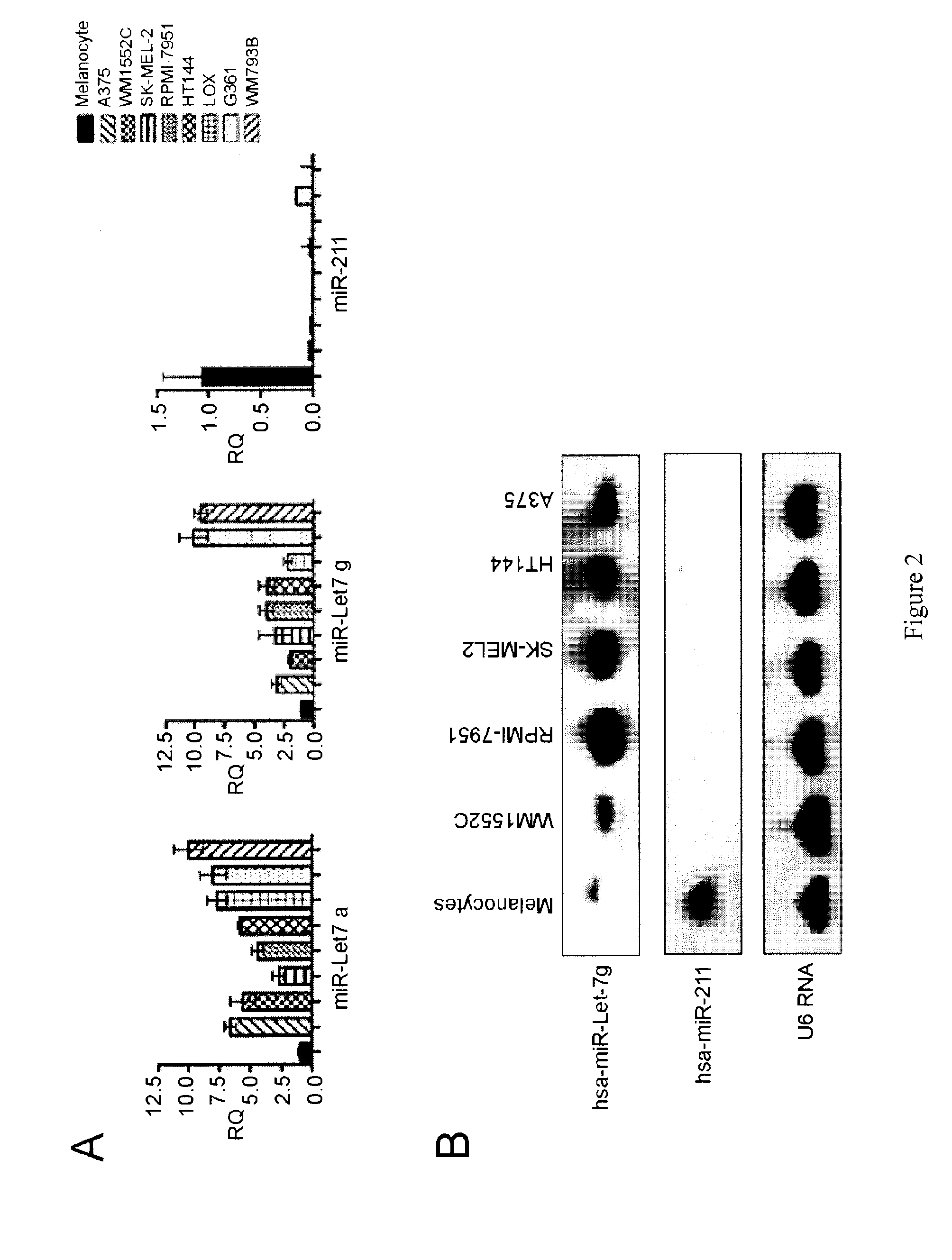Mir-211 expression and related pathways in human melanoma
a human melanoma and gene expression technology, applied in the field of human melanoma diagnosis and treatment, can solve the problems of complex and poorly understood exact molecular mechanisms that lead to melanoma, significant hurdle to its use, and the extent of melanin pigmentation is an important risk factor
- Summary
- Abstract
- Description
- Claims
- Application Information
AI Technical Summary
Benefits of technology
Problems solved by technology
Method used
Image
Examples
example 1
miR-211 is Expressed at a Low Level in Non-Pigmented Melanoma Cell Lines
[0104]The human epidermal melanocyte cell line HEM-1 (ScienCell™, Catalog #2200) and primary epidermal melanoyctes—neonatal (ATCC-PCS-200-012) were grown in Me1M media containing MeIGS growth supplements, 0.5% FBS, and pen / strep solution. The melanoma cell lines examined included: A375 (stage 4, ATCC® Number: CRL-1619), G361 (stage 4, ATCC), LOX-IMV1 (stage 4, ATCC), HT-144 (stage 4, ATCC® Number: HTB-63), RPMI-7951 (stage 4, ATCC® Number: HTB-66), SK-MEL2 (stage 4, ATCC), SK-MEL28 (stage 3, ATCC), WM793B (stage 1, ATCC® Number: CRL-2806), and WM1552C (stage 3, ATCC® Number: CRL-2808). All melanoma cell lines were grown in Complete Tu Media containing a 4:1 mixture of MCDB-153 medium with 1.5 g / L sodium bicarbonate and Leibovitz's L-15 medium with 2 mM L-glutamine, 2% FBS, and 1.68 mM CaCl2. Information regarding all clinical samples, derived from frozen samples, is described in Table 1.
TABLE 1Clinical Sample #T...
example 2
miR-211 Levels in Clinical Melanoma Samples
[0108]miR-211 transcript levels were assayed by qRT-PCR in 30 clinical melanoma samples (six primary, six regional, 12 nodal and six distal metastatic, respectively; described in Table S1). miR-211 expression levels were reduced in 21 of these clinical samples compared to that observed in melanocytes (FIG. 3, Table 3). In the remaining nine melanomas, six (one primary, one regional, two distant, and two nodal metastatic melanomas) showed statistically significant increases in miR-211 expression, whereas expression was not significantly different in the remaining samples. These samples were obtained from different patients; therefore, the observed differences may reflect different processes in melanoma development and progression, individual genetic differences, different proportions of non-melanoma (including non-pigmented) cells in the tumor samples, or a combination of these factors. miR-211 levels were low in the majority (21 / 30) of the ...
example 3
Stable Ectopic Expression of miR-211 in Melanoma Cell Lines Depletes Select Target Transcripts
[0110]For the initial transformation of miRNA array data, the GenePixPro 6.0 global normalization method was employed in which images and results are normalized together. Statistical significance tests were Welsh t-test, nonparametric ANOVA, (e.g., to select genes that have significantly less within sample variance compared to between sample variance), and correlation analysis with Pearson's product moment r and Spearman's r. Analysis was controlled for false discovery rate using q-values, with a priori cut off point of 10 percent
[0111]For mRNA expression array data, commencing with GeneChip® Human Exon 1.0 ST Array (Affymetrix, Inc.) four probes per exon and roughly 40 probes per gene, 7 total arrays were analysed (three arrays for melanocyte RNA, and four arrays for melanoma RNA). Cell files were loaded into Partek® Genomics Suite™ (Partek, Inc. St. Louis, Mo., USA) under the following al...
PUM
| Property | Measurement | Unit |
|---|---|---|
| resistance | aaaaa | aaaaa |
| energy | aaaaa | aaaaa |
| drug resistance | aaaaa | aaaaa |
Abstract
Description
Claims
Application Information
 Login to View More
Login to View More - R&D
- Intellectual Property
- Life Sciences
- Materials
- Tech Scout
- Unparalleled Data Quality
- Higher Quality Content
- 60% Fewer Hallucinations
Browse by: Latest US Patents, China's latest patents, Technical Efficacy Thesaurus, Application Domain, Technology Topic, Popular Technical Reports.
© 2025 PatSnap. All rights reserved.Legal|Privacy policy|Modern Slavery Act Transparency Statement|Sitemap|About US| Contact US: help@patsnap.com



